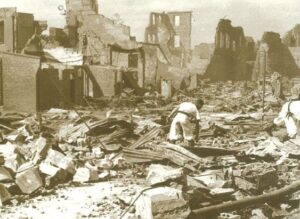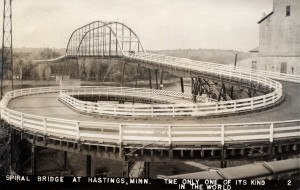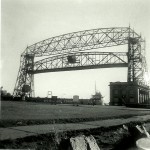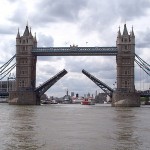hastings

 February 3, 1931, dawned beautiful and calm in Hawke’s Bay, New Zealand, but by the end of the day, few people would be thinking of how the day had started out. At exactly 10:47am the hands of the clock on the band rotunda in Napier stopped turning. That was the moment when the area was hit by a massive 7.8 magnitude earthquake. The quake shook the area for a full three minutes, causing such destruction that it actually changed the topography of the area forever. Buildings were leveled, streets were destroyed, fires broke out, power and phone lines were knocked out, and 256 people lost their lives…161 in Napier, 93 in Hastings, and two in Wairoa. Many thousands more were injured. The 1931 Hawke’s Bay earthquake the deadliest natural disaster in New Zealand’s history.
February 3, 1931, dawned beautiful and calm in Hawke’s Bay, New Zealand, but by the end of the day, few people would be thinking of how the day had started out. At exactly 10:47am the hands of the clock on the band rotunda in Napier stopped turning. That was the moment when the area was hit by a massive 7.8 magnitude earthquake. The quake shook the area for a full three minutes, causing such destruction that it actually changed the topography of the area forever. Buildings were leveled, streets were destroyed, fires broke out, power and phone lines were knocked out, and 256 people lost their lives…161 in Napier, 93 in Hastings, and two in Wairoa. Many thousands more were injured. The 1931 Hawke’s Bay earthquake the deadliest natural disaster in New Zealand’s history.
The earthquake left the people in shock, as they surveyed the damage to their beautiful seaside city. People had trouble breathing, due to dust clouds from shattered buildings, and the roads were filled with huge splits making it impossible to get emergency equipment into the area. When the initial shaking began, people ran panic-stricken out of the buildings and into the street. Many of them were killed instantly when they were struck by falling masonry, as stone decorations on many buildings crashed to the ground. Still others were buried alive in the rubble as the buildings collapsed. To make matters worse, fires were burning throughout the city of Napier for a full 36 hours before they could be contained. Most of the surviving buildings from the initial impact of the quake, were leveled by the fires. Nearby Hastings lost approximately 200 buildings and most of the deaths there were in a single department store, although many died in the public library too. Hastings also suffered from out-of-control fires due to problems with their water supply, but fires weren’t as bad as in Napier.
While the earthquake was a major tragedy, there were numerous acts of heroism that will never be forgotten.  Water for fighting the fires ran out because underground pipes had cracked and broken. Fire engines at Napier’s central fire station were covered in debris from the destroyed brigade building, and they couldn’t be used when fires broke out in the town anyway. Napier Hospital, built only a year earlier, collapsed, claiming the lives of 12 nurses. Rescuers fought to bring out trapped and injured victims from the rubble before the fires reached them. Still, many died in the terrible inferno. With the loss of the Napier Hospital, first responders quickly set up emergency hospitals. Unfortunately, the hospitals lacked the necessary medical supplies, and so the doctors and nurses were limited in what they could do to help the injured. Back-up medical teams were sent from Auckland on board Navy ships and from Wellington by train, but this took time to arrange, and with communication largely out, the communications had to be routed through ships in the harbor, like the HMS Veronica, which had just tied up in the harbor when the quake hit. At first her captain thought there had been an explosion on board…until he saw the wharf twisting and beyond it houses and other buildings crumpling to the ground. It was then that the sickening reality hit him. He quickly sent his sailors ashore to assist with the rescue effort. By the morning of February 4, 1931, the area was filled with rescue workers trying to save anyone they could. Unfortunately, for many, help came too late. Still, a full three days after the quake a 90-year-old man who was buried in the earthquake rubble was finally dug out alive. Miracles do happen.
Water for fighting the fires ran out because underground pipes had cracked and broken. Fire engines at Napier’s central fire station were covered in debris from the destroyed brigade building, and they couldn’t be used when fires broke out in the town anyway. Napier Hospital, built only a year earlier, collapsed, claiming the lives of 12 nurses. Rescuers fought to bring out trapped and injured victims from the rubble before the fires reached them. Still, many died in the terrible inferno. With the loss of the Napier Hospital, first responders quickly set up emergency hospitals. Unfortunately, the hospitals lacked the necessary medical supplies, and so the doctors and nurses were limited in what they could do to help the injured. Back-up medical teams were sent from Auckland on board Navy ships and from Wellington by train, but this took time to arrange, and with communication largely out, the communications had to be routed through ships in the harbor, like the HMS Veronica, which had just tied up in the harbor when the quake hit. At first her captain thought there had been an explosion on board…until he saw the wharf twisting and beyond it houses and other buildings crumpling to the ground. It was then that the sickening reality hit him. He quickly sent his sailors ashore to assist with the rescue effort. By the morning of February 4, 1931, the area was filled with rescue workers trying to save anyone they could. Unfortunately, for many, help came too late. Still, a full three days after the quake a 90-year-old man who was buried in the earthquake rubble was finally dug out alive. Miracles do happen.
Napier was forever changed from this devastating tragedy. The Ahuriri Lagoon and tidal flats that was once a large body of water was completely emptied, and today the area is the site of the Hawke’s Bay Airport. The sea floor just off Hawke’s Bay was lifted approximately 8 feet 10 inches. The main fault, which was buried under the earth’s surface heaved up the land, setting off two smaller faults which broke on the surface. Following the terrible devastation, came resilience and determination in the people, and the area would be rebuilt and 
 improved. The streets were widened when they rebuilt, and services were improved, including New Zealand’s first underground power system. The architectural fashion of the time was known as Art Deco, and central Napier is almost entirely built in variations of this style. One beautiful legacy from an otherwise tragic chapter of Napier’s history.
improved. The streets were widened when they rebuilt, and services were improved, including New Zealand’s first underground power system. The architectural fashion of the time was known as Art Deco, and central Napier is almost entirely built in variations of this style. One beautiful legacy from an otherwise tragic chapter of Napier’s history.
 I never knew my dad to be a big sentimental saver, who kept every little knick knack or scrap of paper, so when he saved something, I have to think that it meant something, or was something special to him. Pictures were the exception, of course, but I was surprised when I found a couple of post cards from his sister, my Aunt Ruth when she was on a trip in 1946. She doesn’t say who she was with, but since she was married at the time, I have to assume that she was with my Uncle Jim. One post card, in particular, stood out for me, mostly I suppose because I like things of historic value. The post card was of the Spiral Bridge in Hastings, Minnesota. Hastings is in southern Minnesota, and while I would have a hard time believing that my dad never made the trip down to see this famous wagon bridge, I have no real proof that he was ever there, but I believe Aunt Ruth went over it on the trip back in May of 1946. Still, whether Dad went over it or not, he must have thought it quite interesting, because he kept the card the rest of his life. Dad was always interested in the historic value of things too, and I’m sure that is where my interest in those things began. He took the time to show us many historic markers and places of interest.
I never knew my dad to be a big sentimental saver, who kept every little knick knack or scrap of paper, so when he saved something, I have to think that it meant something, or was something special to him. Pictures were the exception, of course, but I was surprised when I found a couple of post cards from his sister, my Aunt Ruth when she was on a trip in 1946. She doesn’t say who she was with, but since she was married at the time, I have to assume that she was with my Uncle Jim. One post card, in particular, stood out for me, mostly I suppose because I like things of historic value. The post card was of the Spiral Bridge in Hastings, Minnesota. Hastings is in southern Minnesota, and while I would have a hard time believing that my dad never made the trip down to see this famous wagon bridge, I have no real proof that he was ever there, but I believe Aunt Ruth went over it on the trip back in May of 1946. Still, whether Dad went over it or not, he must have thought it quite interesting, because he kept the card the rest of his life. Dad was always interested in the historic value of things too, and I’m sure that is where my interest in those things began. He took the time to show us many historic markers and places of interest.
 The Spiral Bridge was built over the Mississippi River in 1895 as a wagon bridge. It was built with a large spiral ramp on the south end to allow enough clearance for the river traffic to pass below the bridge. These days we would have a vertical lift bridge, such as the one at Duluth Harbor, or a draw bridge, like the Tower Bridge, but back then, they didn’t have the capability to build such a bridge and the river traffic had to get through. The Spiral Bridge easily handled the river traffic and the wagon traffic. In 1895, there weren’t many cars around, and most people still traveled by horse and wagon. A bridge that had too steep a rise would be really hard for horses, so it was necessary, for the sake of continuing the movement of river traffic, to create a ramp of sorts so the bridge was high enough. The spiral ramp on the Spiral Bridge did just that.
The Spiral Bridge was built over the Mississippi River in 1895 as a wagon bridge. It was built with a large spiral ramp on the south end to allow enough clearance for the river traffic to pass below the bridge. These days we would have a vertical lift bridge, such as the one at Duluth Harbor, or a draw bridge, like the Tower Bridge, but back then, they didn’t have the capability to build such a bridge and the river traffic had to get through. The Spiral Bridge easily handled the river traffic and the wagon traffic. In 1895, there weren’t many cars around, and most people still traveled by horse and wagon. A bridge that had too steep a rise would be really hard for horses, so it was necessary, for the sake of continuing the movement of river traffic, to create a ramp of sorts so the bridge was high enough. The spiral ramp on the Spiral Bridge did just that.
With his interest in historic, and unique things, I can hardly imagine that this historic bridge would be the thing my dad would have missed. Sadly, it is not something we can go see today, because it was torn down in 1951 to make way for a high bridge that would provide a straighter entry and make modern day traffic flow more smoothly. The spiral ramp, while a great idea for wagons, slowed automobile traffic considerably. With the  modern day automobile, came the need for a new bridge, and the Spiral Bridge, while historic and unique, was nevertheless obsolete. I suppose the builders of the new bridge were excited to see a brand new, modern bridge take the place of the old, outdated bridge, but I like antiques. Houses, bridges, furniture, and even cars, provided that I don’t have to drive them much, all hold my interest, but there are people who prefer to have everything very modern. I suppose too, that it was a necessity, and they just couldn’t move the new one to a different location. Whatever the case may have been, I’m glad my Aunt Ruth and Uncle Jim got to see it, and I really hope my dad and the rest of the family did too. It was a little bit of history that I know they would have loved. Bridges are cool, but the Spiral Bridge was amazing.
modern day automobile, came the need for a new bridge, and the Spiral Bridge, while historic and unique, was nevertheless obsolete. I suppose the builders of the new bridge were excited to see a brand new, modern bridge take the place of the old, outdated bridge, but I like antiques. Houses, bridges, furniture, and even cars, provided that I don’t have to drive them much, all hold my interest, but there are people who prefer to have everything very modern. I suppose too, that it was a necessity, and they just couldn’t move the new one to a different location. Whatever the case may have been, I’m glad my Aunt Ruth and Uncle Jim got to see it, and I really hope my dad and the rest of the family did too. It was a little bit of history that I know they would have loved. Bridges are cool, but the Spiral Bridge was amazing.

